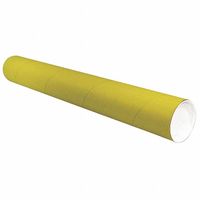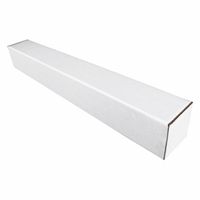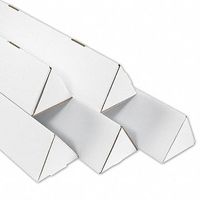Call +(254) 703 030 000 / 751 483 999 / 721 704 777
- Home
- Packaging Shipping
- Shipping Boxes Pads Tubes
- Mailing Tubes
.....Read More
Frequently Asked Questions
What are mailing tubes made of?
Mailing tubes are primarily made of durable materials designed to protect their contents during shipping. The most common material used is cardboard, specifically a type of heavy-duty, spiral-wound kraft paper. This construction provides strength and rigidity, ensuring that the tube can withstand the rigors of handling and transportation without collapsing or bending. The kraft paper is often layered and glued together to form a thick, sturdy wall.
In addition to cardboard, some mailing tubes are made from plastic, such as polyethylene or polypropylene. These plastic tubes offer additional protection against moisture and are often used for items that require a higher level of durability or water resistance. Plastic mailing tubes can also be transparent, allowing for easy identification of the contents without opening the tube.
For specialized applications, mailing tubes can be made from metal, such as aluminum or steel. These are used for extremely fragile or valuable items that need maximum protection. Metal tubes are less common due to their higher cost and weight.
The ends of mailing tubes are typically sealed with plastic or metal caps, which can be either snap-on or screw-on. These caps secure the contents and prevent them from sliding out during transit. Some mailing tubes also feature self-locking mechanisms or adhesive closures for added security.
Overall, the choice of material for mailing tubes depends on the specific requirements of the items being shipped, including their size, weight, and fragility, as well as environmental considerations like moisture exposure.
How do mailing tubes protect items during shipment?
Mailing tubes protect items during shipment by providing a sturdy, cylindrical container that minimizes the risk of damage. Their round shape distributes pressure evenly, reducing the likelihood of crushing compared to flat packaging. Made from durable materials like cardboard, plastic, or metal, mailing tubes offer a rigid barrier against external forces, safeguarding contents from bending, folding, or tearing.
The snug fit of items within the tube prevents movement during transit, reducing the risk of damage from jostling or impact. End caps or closures secure the contents, preventing them from slipping out. These caps are often designed to be tamper-evident, adding an extra layer of security against unauthorized access.
Mailing tubes are particularly effective for shipping rolled items such as posters, blueprints, or artwork, as they maintain the integrity of the items' shape. The tube's interior can be lined or cushioned to provide additional protection against moisture, dust, or abrasion.
Furthermore, mailing tubes are often lightweight, which helps in reducing shipping costs while still providing robust protection. Their design allows for easy labeling and handling, ensuring that they can be efficiently processed through postal systems.
In summary, mailing tubes protect items during shipment by offering a combination of structural integrity, secure closure, and protection against environmental factors, ensuring that contents arrive at their destination in pristine condition.
Can mailing tubes be used for shipping fragile items?
Yes, mailing tubes can be used for shipping fragile items, but certain precautions must be taken to ensure the safety of the contents. Mailing tubes are cylindrical containers typically made from cardboard, plastic, or metal, and are commonly used for shipping documents, posters, and other rolled items. When shipping fragile items, consider the following:
1. **Material and Strength**: Choose a mailing tube made from a durable material. Heavy-duty cardboard or reinforced plastic tubes offer better protection against crushing and impacts compared to standard cardboard tubes.
2. **Size and Fit**: Ensure the tube is the appropriate size for the item. The item should fit snugly without excessive movement, which can cause damage during transit.
3. **Padding and Protection**: Wrap the fragile item in bubble wrap or foam padding before placing it in the tube. This provides an additional layer of protection against shocks and vibrations.
4. **End Caps**: Securely fasten the end caps of the tube. Some tubes come with plastic or metal end caps that can be taped or glued for extra security. Ensure the caps are tight to prevent the item from sliding out.
5. **Labeling**: Clearly label the tube as "Fragile" to alert handlers to take extra care. Use bright, noticeable labels or stickers.
6. **Insurance and Tracking**: Consider purchasing insurance and tracking for the shipment. This provides financial protection in case of damage and allows you to monitor the package's progress.
7. **Shipping Method**: Choose a reliable shipping service known for handling fragile items with care. Some services offer special handling options for delicate shipments.
By taking these precautions, mailing tubes can be an effective option for shipping fragile items, ensuring they arrive safely at their destination.
What sizes do mailing tubes come in?
Mailing tubes come in a variety of sizes to accommodate different needs. The diameter of mailing tubes typically ranges from 1 inch to 12 inches. Common diameters include 1.5 inches, 2 inches, 3 inches, and 4 inches. The length of mailing tubes can vary significantly, with standard lengths ranging from 6 inches to 48 inches. However, custom lengths can be ordered to fit specific requirements.
For smaller items like posters or blueprints, tubes with a diameter of 2 to 3 inches and lengths of 18 to 36 inches are often used. Larger items, such as architectural plans or large-format prints, may require tubes with diameters of 4 inches or more and lengths extending up to 48 inches or longer.
Mailing tubes are also available in different thicknesses, which can affect their durability and protection level. Standard wall thicknesses are typically around 0.06 inches, but heavy-duty options with thicker walls are available for added protection during shipping.
In addition to size, mailing tubes can come with different closure types, such as plastic end caps, metal end caps, or self-sealing ends, which can influence the overall length and usability of the tube.
Overall, the variety in sizes and specifications allows mailing tubes to be versatile shipping solutions for a wide range of items, from small documents to large, bulky materials.
Are mailing tubes reusable?
Yes, mailing tubes are reusable. They are designed to be durable and sturdy, often made from materials like cardboard, plastic, or metal, which can withstand multiple uses. Reusing mailing tubes is an environmentally friendly practice that reduces waste and conserves resources.
To reuse a mailing tube, ensure it is in good condition without significant damage such as tears, dents, or moisture exposure. If the tube has labels or tape from previous use, remove them to avoid confusion during the next mailing. You can also reinforce the tube with additional tape if necessary to ensure it remains secure during transit.
Mailing tubes can be reused for various purposes beyond shipping. They can serve as storage containers for documents, posters, or artwork. They are also useful for organizing items like cables or tools. In creative projects, mailing tubes can be repurposed into craft materials or used in DIY projects.
When reusing mailing tubes for shipping, ensure the contents are properly protected. Use bubble wrap, packing paper, or other cushioning materials to prevent damage. Securely seal the ends of the tube with strong tape to ensure it remains closed during transit.
Overall, reusing mailing tubes is a practical and sustainable option that benefits both the environment and your budget.
How do you seal a mailing tube?
To seal a mailing tube, follow these steps:
1. **Prepare the Contents**: Roll the document or item tightly and secure it with a rubber band or string to prevent unrolling.
2. **Insert the Item**: Carefully slide the rolled item into the mailing tube, ensuring it fits snugly without forcing it.
3. **Cap the Ends**: Place the plastic or metal caps provided with the tube onto each end. Ensure they fit securely. If the tube doesn't come with caps, use a sturdy material like cardboard cut to size.
4. **Tape the Caps**: Use strong packing tape to secure the caps. Wrap the tape around the circumference of the tube where the cap meets the tube. Ensure the tape overlaps slightly for added security.
5. **Reinforce the Seal**: For extra protection, apply additional layers of tape across the ends in a crisscross pattern. This helps prevent the caps from popping off during transit.
6. **Label the Tube**: Write the recipient's address and your return address clearly on the tube. Use a permanent marker or affix a printed label. Ensure the label is securely attached and not covering any seams.
7. **Add Fragile Stickers**: If the contents are delicate, apply "Fragile" stickers to alert handlers to take extra care.
8. **Check for Gaps**: Inspect the tube for any gaps or weak spots in the tape. Reinforce as necessary to ensure the tube is completely sealed.
9. **Weigh and Measure**: Weigh the tube and measure its dimensions to determine postage costs.
10. **Postage**: Affix the correct postage, ensuring it is visible and not obstructed by tape or labels.
Your mailing tube is now ready for shipping.
Where can I buy mailing tubes?
You can purchase mailing tubes from a variety of sources, both online and in physical stores. Here are some options:
1. **Office Supply Stores**: Retailers like Staples, Office Depot, and OfficeMax often carry a selection of mailing tubes in various sizes. You can visit their physical locations or check their websites for online ordering.
2. **Shipping and Packaging Stores**: Stores like The UPS Store, FedEx Office, and local packaging supply shops typically stock mailing tubes. They may offer different sizes and can provide advice on the best options for your needs.
3. **Online Retailers**: Websites like Amazon, eBay, and Walmart offer a wide range of mailing tubes. You can find different sizes, materials, and quantities, often with customer reviews to help guide your purchase.
4. **Specialty Packaging Suppliers**: Companies like Uline, PackagingSupplies.com, and Paper Mart specialize in packaging materials and offer a comprehensive selection of mailing tubes. These suppliers often provide bulk purchasing options, which can be cost-effective for businesses.
5. **Art Supply Stores**: If you need mailing tubes for artwork or posters, art supply stores like Michaels or Blick Art Materials may have suitable options.
6. **Warehouse Clubs**: Membership-based warehouse clubs like Costco or Sam's Club sometimes carry mailing tubes, especially in bulk quantities.
7. **Local Print Shops**: Some local print and copy shops may sell mailing tubes, particularly if they offer shipping services.
8. **DIY and Craft Stores**: Stores like Hobby Lobby or Joann might have mailing tubes, especially if you are looking for decorative or specialty options.
Consider factors like size, durability, and cost when choosing where to buy mailing tubes.


